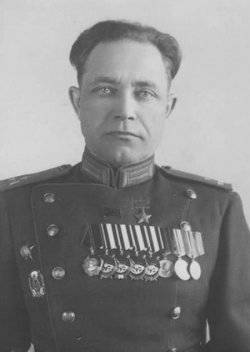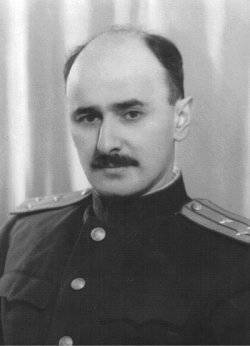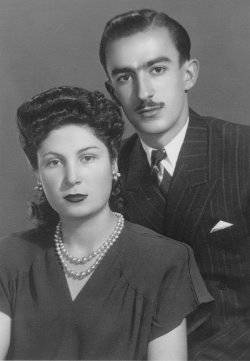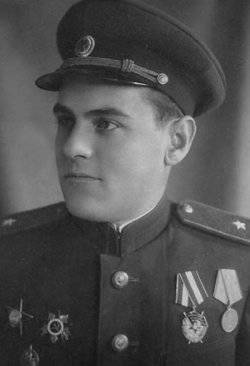The failure of the operation "Long Jump"
 On the 70 anniversary of the Tehran Conference of the Allied Powers 1943 of the Year
On the 70 anniversary of the Tehran Conference of the Allied Powers 1943 of the YearThe end of 1943 was nearing the middle of World War II. The main aggressor, Nazi Germany, the Soviet Armed Forces struck one after another two deadly blows - near Stalingrad and Kursk - and set it before a catastrophe. The allies of the USSR in the anti-Hitler coalition — the United States and Great Britain — carried out a number of successful operations in North Africa (the German corps of Rommel near El Alamein was defeated in Egypt, occupied Morocco and Algeria, conducted the Sicilian landing operation and landed in the south of the Apennine Peninsula).
For the allies of the USSR, it was time for active negotiations on the opening of the Second Front and the post-war structure of the world, and for Germany - the adoption of urgent measures to save the situation. Hitler, as always prone to adventures, chose the organization of a terrorist act against the leaders of the three powers as one of the methods, in case they gather for a joint meeting (conference).
After quite lengthy negotiations, which lasted from August to early November 1943 of the year (time sufficient for information leakage), the allies came to the conclusion that Tehran could be the most suitable meeting place. However, they were guided by several considerations to ensure the safety of its implementation. First of all, Tehran and northern Iran, according to the Soviet-Iranian 1921 Treaty, were controlled from the end of 1941 by the Soviet troops (45 and 46 Army, 182-Rifle Division of 62 was directly deployed in Tehran army), which ensured the safety of delivery of military goods in the USSR by Lend-Lease.
 Secondly, Tehran was relatively close to Britain and the Soviet Union. Third, the real positions of the German intelligence services in Tehran were limited to intelligence and additional efforts were required to carry out the attacks, while the capabilities of Soviet intelligence, counterintelligence and military forces corresponded to the operational situation prevailing at that time in Tehran and the country as a whole. Finally, the weather conditions in Tehran at the end of November were favorable.
Secondly, Tehran was relatively close to Britain and the Soviet Union. Third, the real positions of the German intelligence services in Tehran were limited to intelligence and additional efforts were required to carry out the attacks, while the capabilities of Soviet intelligence, counterintelligence and military forces corresponded to the operational situation prevailing at that time in Tehran and the country as a whole. Finally, the weather conditions in Tehran at the end of November were favorable.The German intelligence services — the imperial security service and the Abwehr — made great efforts to clarify the meeting place of the Allied powers and disrupt its work. Only by the beginning of November 1943, they were able to establish that Tehran was chosen to be the meeting place of Stalin, Roosevelt and Churchill. The feverish work on its breakdown began.
Hitler entrusted this complicated matter to Abwehr’s head Canaris and the foreign intelligence chief of the imperial security service, Schellenberg, who began by training several special terrorist groups to send them to Tehran. To this end, a special school was established in Copenhagen. The terrorist operation began to bear the name "Long Jump".
The Soviet side foresaw such actions by the German special services, it managed to obtain a series of data from foreign residencies. And above all, from the intelligence officer of the operational group "Winners" Nikolai Kuznetsov. In the middle of November 1943, he was told in confidence by SS officer Ulrich von Ortel that he would soon be sent with a “special assignment” to Iran.
Without counting on the complete accuracy of this information, the Soviet leadership nevertheless undertook a number of operational countermeasures. First of all, it stepped up the activity of the Soviet residency in Tehran. From August 1941 until the end of 1946, she was led by Colonel Agayants Ivan Ivanovich, a talented Soviet intelligence officer who gave over to the foreign intelligence service more than 30 years of his life. Agayants, in addition to the existing peripheral residencies and intelligence officers, managed to attract the Amira youth group during the preparation of the Tehran conference, which was led by a young but capable intelligence officer - 17-year-old youth Gevork Vartanian, the future Hero of the Soviet Union.
To coordinate the activities of Soviet counterintelligence at the suggestion of the head of the Smersh, USSR Commissar of Defense, General V.S. Abakumov urgently sent a military counterintelligence lieutenant colonel Nikolai Grigorievich Kravchenko to Tehran, who in a short time managed to organize the security of the conference of the three powers by the forces of the Smersh units of the Red Army units deployed in Iran. He promptly agreed on the necessary issues with the military command and ensured the safety of the heads of state along the route from the airfield and at the places of stay.
The 131 motorized rifle regiment of the NKVD of the USSR, which arrived in Tehran in late October of the 1943 of the year and replaced the 182 th mountain rifle regiment of the 62 th rifle division of the 45 army, played a significant role in ensuring the security of the meeting of the three heads of states. The regiment numbered about 1.200 people, had the most modern at the time weapons and vehicles. The commander of the regiment was Hero of the Soviet Union, Colonel N.F. The Caymans, his deputies were: in the political part — Hero of the Soviet Union, Lieutenant Colonel N.М. Rudenko, according to the drill - Hero of the Soviet Union, captain I.D. Chernopyatko.
These were experienced officers who received baptism of fire even while defending the state border. For example, Captain Chernopyatko distinguished himself while repelling the attacks of the Japanese in the area of Lake Hassan to the height of Zaozerye in 1938, when he, along with his comrades I.G. Batarshin, V.M. Vinevitin, P.F. Tereshkin managed to maintain an important height for several days. Despite their injuries, they emerged victorious from the battlefield.
The regimental commander Nikita Fadeyevich Caymanov and his deputy for political affairs, Lieutenant Colonel Rudenko, accomplished their combat exploits in the first days of the Great Patriotic War. So, Senior Lieutenant Cayman, leading the combined squad of several border outposts of the 1941 th border detachment of the Karelo-Finnish frontier district (80 fighters) at the end of June of the 146, (19 days), fought in full surroundings and managed not only to keep the occupied boundary, but also repel Finnish troops before 60, causing them great damage. With minimal casualties (18 killed), he broke out of the encirclement and, after making an almost 120-kilometer march through the marshland, joined up with the Red Army units.
Upon arrival in Tehran, the regimental commander was acquainted with the operational and political situation in Tehran by our resident colonel I.I. Agayants and received from him the necessary instructions.
The next day, Colonel Cayman held a reconnaissance of Tehran and its environs, as a result of which he clarified the objects of protection, the necessary forces and means for this. Determined the order of protection of the airfield, the route of the heads of state, the order of strengthening the protection of the USSR Embassy in Tehran, the palace of the Shah of Iran and the composition of the reserve. A month before the conference, his subordinates had the opportunity to master their facilities and comprehensively prepare for ensuring the safety of their work.
 SOVIET agents, located in the city of Qom (70 km south of Tehran), reported that 14 November 1943, a few kilometers from the city, paraded an advanced group of 6 saboteurs who were moving in the direction of Tehran. Soviet resident Agayants immediately informed about this lieutenant colonel Kravchenko and the commander of the 131 motorized rifle regiment colonel Kaymanov. At the same time, he clarified the tasks of his agency in Tehran, as well as the group “Amir”.
SOVIET agents, located in the city of Qom (70 km south of Tehran), reported that 14 November 1943, a few kilometers from the city, paraded an advanced group of 6 saboteurs who were moving in the direction of Tehran. Soviet resident Agayants immediately informed about this lieutenant colonel Kravchenko and the commander of the 131 motorized rifle regiment colonel Kaymanov. At the same time, he clarified the tasks of his agency in Tehran, as well as the group “Amir”.It was precisely on this group of “light cavalry,” as it was called in the Tehran residency, that Agayants had particular hopes. The young scouts, having organized several search groups, for days, as Gevorg Vartanian’s future wife Gohar recalled later, went around the city and managed to track down the terrorists in a conspiratorial villa on the outskirts of the city prepared for them by German agents.
Then the link Agayants - Caymans worked, German saboteurs were arrested. One of them showed that the terrorist act was planned on November 30, the birthday of English Prime Minister Winston Churchill.
But the Soviet side did not yet have complete confidence that the attempt to make the attempt was over. Therefore, it was decided to strengthen the intelligence, counterintelligence and physical protection of the “Big Three”. Colonel Agayants set new tasks for his agents around the airport, on the route and around the embassies of the conference participants, and Lieutenant-Colonel Kravchenko, after weighing all the pros and cons, suggested placing the American delegation in a securely guarded Soviet embassy in order to avoid unnecessary risk. The fact is that the US Embassy was one and a half kilometers from the Soviet, and the British - literally next to the Soviet.
The Soviet leadership approved this proposal, and it was handed over to the Americans. They agreed. At the same time, it was decided to imitate President Roosevelt’s presence in the American embassy for the entire duration of the conference (external security was reinforced, additional patrols were allocated, and false departures were planned).
By the morning of November 27, all the preparatory measures to ensure the security of the leaders of the three powers were completed, as reported to Stalin.
At this time, Hitler, having received a message about the failure of an advanced group of saboteurs, thrown into the area of Qom, decided not to risk the main group, which Otto Skorzeny was to lead, and refused to further carry out Operation Big Jump.
But the task of the German agent in Tehran remained the same - to use all the possibilities to capture or liquidate the heads of the three powers. And punctual Germans tried to use these opportunities to the maximum (they increased the intelligence of the embassies, tried to equip snipers' positions in convenient places, took control of bridges and intersections of roads and streets along the route of the Allied delegations from the airport to the city).
The Soviet side, in turn, did everything possible to prevent and neutralize the terrorist intentions of the German agents. Three days before the arrival of the heads of government, the security of the capital’s airport was tightened (the landing sites of the aircraft, the terminal building, and the entrances to it). Additional posts were set up along the whole route of the tuples. The latter included motor vehicles and escort motorcycles, as well as police special vehicles. Special measures were taken at the corners of the road and intersections, where special posts from the units of the 131-th motorized rifle regiment of the NKVD were set up.
All heads of state - Stalin, Roosevelt, Churchill - 27 November 1943 flew safely to Tehran, reached their residences without incident (Roosevelt, as it was due, arrived at the Soviet embassy) and began their work at 16 hours of November 28.
True, the beginning of the conference was not without incident. In the middle of November 28, when two cars left the American embassy, allegedly heading for a meeting (it was a false exit), they were fired from machine guns from the nearest building. No one was hurt. The terrorists were eliminated.
For the residency of Colonel Agayants, the commander of the regiment Kaymanov and security coordinator for delegations Lieutenant-Colonel Kravchenko, all six days of the “Big Three” in Tehran, from November 27 to December 2 1943, were a period of intense round-the-clock work, full of hazards and various kinds of incidents. Several dozen suspicious persons were arrested and several armed provocations were stopped.
 DECEMBER 1, on the final day of the conference meeting, Roosevelt and Churchill asked Stalin to show them a man who so clearly and flawlessly ensured the safety of the conference. Stalin immediately introduced them to a tall one, with a slight smile and a clever, penetrating gaze of Lieutenant Colonel Nikolai Kravchenko. Roosevelt, without concealing his admiration for the Russian hero, noted that before them was a real general. Stalin, in confirmation of this appreciation in a calm voice, said that before them was really not a lieutenant colonel, but Major General Nikolai Grigorievich Kravchenko.
DECEMBER 1, on the final day of the conference meeting, Roosevelt and Churchill asked Stalin to show them a man who so clearly and flawlessly ensured the safety of the conference. Stalin immediately introduced them to a tall one, with a slight smile and a clever, penetrating gaze of Lieutenant Colonel Nikolai Kravchenko. Roosevelt, without concealing his admiration for the Russian hero, noted that before them was a real general. Stalin, in confirmation of this appreciation in a calm voice, said that before them was really not a lieutenant colonel, but Major General Nikolai Grigorievich Kravchenko.All senior officials of the Soviet state security agencies responsible for ensuring the security of the conference were awarded orders. 36 soldiers and officers of the 131 th motorized rifle regiment of the NKVD troops also received high awards: 1 man - the Order of Lenin, 12 - the Order of the Red Banner, 9 - the Order of the Red Star, 7 - the medal "For Courage" and 7 - the Medal "For Bravery", and XNUMX - the medal "For Courage" and XNUMX - the Medal "For Bravery", XNUMX - the Order of the Red Star, XNUMX - the medal "For Courage" and XNUMX - the Medal "For Bravery", and XNUMX - the medal "For Courage" and XNUMX - the Medal "For Bravery", XNUMX - the Order of the Red Star, XNUMX - the medal "For Bravery" and XNUMX - for the Medal "For Bravery", and XNUMX - for the Red Star, the Medal "For Bravery" and XNUMX - for the Medal "For Bravery", for the Red Star, for the Courage and XNUMX - for the Medal "For Brave" ".
All the leaders of the Allied states returned safely to their countries, and the 131 Motorized Rifle Regiment continued to maintain its combat watch in Tehran until September 1945, and then was withdrawn to the territory of the Soviet Union.
Thus, Soviet intelligence and counterintelligence were able to replay Hitler's special services. They disrupted their Long Jump operation and ensured the security of the three Allied leaders, Stalin, Roosevelt and Churchill, who were holding the conference in Tehran.
True, some researchers have doubts about the reality of Hitler’s and his special services’s operation “Big Leap” (V. Chernyavsky, Y. Mader, S. Chuev), but this does not detract from the effectiveness of the work of Soviet intelligence and counterintelligence officers and does not diminish values of security measures during the Tehran conference.
The experience of ensuring the security of the event at the highest level (as it is customary to say today at the summit) made it possible to successfully accomplish this task at subsequent conferences of the Allied powers (Yalta - February 1945 of the year and Potsdam - July 1945 of the year). This experience is also instructive for modern conditions, when the activities of extremist organizations that rely on terrorism have become a real threat during various international forums.
Information